formerly eScholarship Editions


|
|
|
|
Your request for similar items found 20 book(s). | Modify Search | Displaying 1 - 20 of 20 book(s) | |
| 1. | 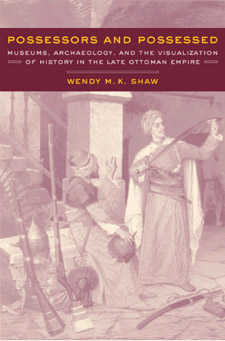 | Title: Possessors and possessed: museums, archaeology, and the visualization of history in the late Ottoman Empire Author: Shaw, Wendy M. K 1970- Published: University of California Press, 2003 Subjects: History | Middle Eastern Studies | Art | Middle Eastern History Publisher's Description: Possessors and Possessed analyzes how and why museums - characteristically Western institutions - emerged in the late-nineteenth-century Ottoman Empire. Shaw argues that, rather than directly emulating post-Enlightenment museums of Western Europe, Ottoman elites produced categories of collection and modes of display appropriate to framing a new identity for the empire in the modern era. In contrast to late-nineteenth-century Euro-American museums, which utilized organizational schema based on positivist notions of progress to organize exhibits of fine arts, Ottoman museums featured military spoils and antiquities long before they turned to the "Islamic" collections with which they might have been more readily associated. The development of these various modes of collection reflected shifting moments in Ottoman identity production. Shaw shows how Ottoman museums were able to use collection and exhibition as devices with which to weave counter-colonial narratives of identity for the Ottoman Empire. Impressive for both the scope and the depth of its research, Possessors and Possessed lays the groundwork for future inquiries into the development of museums outside of the Euro-American milieu. [brief] Similar Items |
| 2. |  | Title: Jewish life in renaissance Italy Author: Bonfil, Roberto Published: University of California Press, 1994 Subjects: Jewish Studies | Renaissance History | European History Publisher's Description: With this heady exploration of time and space, rumors and silence, colors, tastes, and ideas, Robert Bonfil recreates the richness of Jewish life in Renaissance Italy. He also forces us to rethink conventional interpretations of the period, which feature terms like "assimilation" and "acculturation." Questioning the Italians' presumed capacity for tolerance and civility, he points out that Jews were frequently uprooted and persecuted, and where stable communities did grow up, it was because the hostility of the Christian population had somehow been overcome.After the ghetto was imposed in Venice, Rome, and other Italian cities, Jewish settlement became more concentrated. Bonfil claims that the ghetto experience did more to intensify Jewish self-perception in early modern Europe than the supposed acculturation of the Renaissance. He shows how, paradoxically, ghetto living opened and transformed Jewish culture, hastening secularization and modernization.Bonfil's detailed picture reveals in the Italian Jews a sensitivity and self-awareness that took into account every aspect of the larger society. His inside view of a culture flourishing under stress enables us to understand how identity is perceived through constant interplay - on whatever terms - with the Other. [brief] Similar Items |
| 3. | 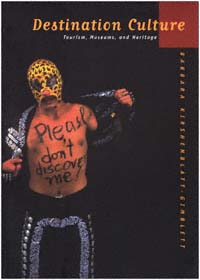 | Title: Destination culture: tourism, museums, and heritage Author: Kirshenblatt-Gimblett, Barbara Published: University of California Press, 1998 Subjects: Art | Art Theory | Popular Culture | Cultural Anthropology | Travel Publisher's Description: Destination Culture takes the reader on an eye-opening journey from ethnological artifacts to kitsch. Posing the question, "What does it mean to show?" Barbara Kirshenblatt-Gimblett explores the agency of display in a variety of settings: museums, festivals, world's fairs, historical re-creations, memorials, and tourist attractions. She talks about how objects - and people - are made to "perform" their meaning for us by the very fact of being collected and exhibited, and about how specific techniques of display, not just the things shown, convey powerful messages. Her engaging analysis shows how museums compete with tourism in the production of "heritage." To make themselves profitable, museums are marketing themselves as tourist attractions. To make locations into destinations, tourism is staging the world as a museum of itself. Both promise to deliver heritage. Although heritage is marketed as something old, she argues that heritage is actually a new mode of cultural production that gives a second life to dying ways of life, economies, and places. The book concludes with a lively commentary on the "good taste/bad taste" debate in the ephemeral "museum of the life world," where everyone is a curator of sorts and the process of converting life into heritage begins. [brief] Similar Items |
| 4. | 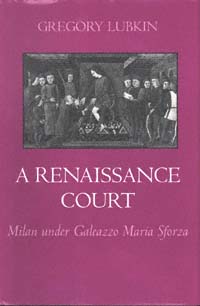 | Title: A Renaissance court: Milan under Galeazzo Maria Sforza Author: Lubkin, Gregory Published: University of California Press, 1994 Subjects: History | Renaissance History Publisher's Description: Ambitious, extravagant, progressive, and sexually notorious, Galeazzo Maria Sforza inherited the ducal throne of Milan in 1466, at the age of twenty-two. Although his reign ended tragically only ten years later, the young prince's court was a dynamic community where arts, policy making, and the panoply of state were integrated with the rhythms and preoccupations of daily life. Gregory Lubkin explores this vital but overlooked center of power, allowing the members of the Milanese court to speak for themselves and showing how dramatically Milan and its ruler exemplified the political, cultural, religious, and economic aspirations of Renaissance Italy. [brief] Similar Items |
| 5. | 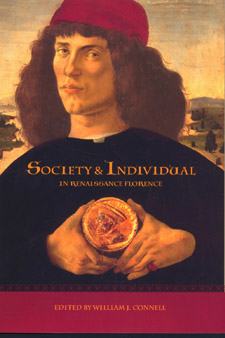 | Title: Society and individual in Renaissance Florence Author: Connell, William J Published: University of California Press, 2002 Subjects: History | Renaissance History | European History Publisher's Description: Renaissance Florence has often been described as the birthplace of modern individualism, as reflected in the individual genius of its great artists, scholars, and statesmen. The historical research of recent decades has instead shown that Florentines during the Renaissance remained enmeshed in relationships of family, neighborhood, guild, patronage, and religion that, from a twenty-first-century perspective, greatly limited the scope of individual thought and action. The sixteen essays in this volume expand the groundbreaking work of Gene Brucker, the historian in recent decades who has been most responsible for the discovery and exploration of these pre-modern qualities of the Florentine Renaissance. Exploring new approaches to the social world of Florentines during this fascinating era, the essays are arranged in three groups. The first deals with the exceptionally resilient and homogenous Florentine merchant elite, the true protagonist of much of Florentine history. The second considers Florentine religion and Florence's turbulent relations with the Church. The last group of essays looks at criminals, expatriates, and other outsiders to Florentine society. [brief] Similar Items |
| 6. | 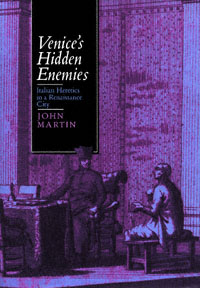 | Title: Venice's hidden enemies: Italian heretics in a Renaissance city Author: Martin, John Jeffries Published: University of California Press, 1993 Subjects: History | European History | Christianity | Renaissance History Publisher's Description: How could early modern Venice, a city renowned for its political freedom and social harmony, also have become a center of religious dissent and inquisitorial repression? To answer this question, John Martin develops an innovative approach that deftly connects social and cultural history. The result is a profoundly important contribution to Renaissance and Reformation studies.Martin offers a vivid re-creation of the social and cultural worlds of the Venetian heretics - those men and women who articulated their hopes for religious and political reform and whose ideologies ranged from evangelical to anabaptist and even millenarian positions. In exploring the connections between religious beliefs and social experience, he weaves a rich tapestry of Renaissance urban life that is sure to intrigue all those involved in anthropological, religious, and historical studies - students and scholars alike. [brief] Similar Items |
| 7. |  | Title: How fascism ruled women: Italy, 1922-1945 Author: De Grazia, Victoria Published: University of California Press, 1992 Subjects: History | European History | Women's Studies Publisher's Description: Italy has been made; now we need to make the Italians," goes a familiar Italian saying. Mussolini was the first head of state to include women in this mandate. How the fascist dictatorship defined the place of women in modern Italy and how women experienced the Duce 's rule are the subjects of Victoria de Grazia's new work. De Grazia draws on an array of sources - memoirs and novels, the images, songs, and events of mass culture, as well as government statistics and archival reports. She offers a broad yet detailed characterization of Italian women's ambiguous and ambivalent experience of a regime that promised modernity, yet denied women emancipation.Always attentive to the great diversity among women and careful to distinguish fascist rhetoric from the practices that really shaped daily existence, the author moves with ease from the public discourse about femininity to the images of women in propaganda and commercial culture. She analyzes fascist attempts to organize women and the ways in which Mussolini's intentions were received by women as social actors. The first study of women's experience under Italian fascism, this is also a history of the making of contemporary Italian society. [brief] Similar Items |
| 8. | 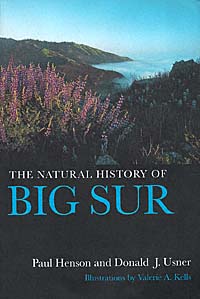 | Title: The natural history of Big Sur Author: Henson, Paul 1959- Published: University of California Press, 1993 Subjects: Environmental Studies | California and the West | Natural History | Ecology Publisher's Description: Each year millions of people visit the area of rugged California coastline and wild mountains known as Big Sur. Finally here is a book that is both a natural history of this beautiful region and an excellent guide to its extensive public lands. The first section introduces the area's geology, climate, flora, fauna, and human history. The second section describes selected sites, trails, and features that are mentioned in Part One.Although Big Sur is world famous for awe-inspiring scenery, it is less known for its great ecological diversity and its significance as a haven for many species of terrestrial and marine wildlife. In no other part of the world do fog-loving coastal redwoods thrive on one slope of a canyon while arid-climate yuccas grow on the other. Similarly, sea otters and cormorants live near dry-climate creatures like canyon wrens and whiptail lizards. The area's staggering beauty and forbidding wilderness have inspired artists, poets, naturalists, and hikers - and also real estate developers.As increasing tourism, development pressure, and land-use decisions continue to affect Big Sur, this book will do much to heighten awareness of the region's biotic richness and fragility. Written in nontechnical language, with generous color photographs, drawings, maps, species lists, and a bibliography, it will attract both the casual and the serious naturalist, as well as anyone concerned about preserving California's natural heritage. [brief] Similar Items |
| 9. | 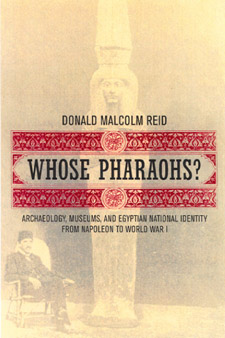 | Title: Whose pharaohs?: archaeology, museums, and Egyptian national identity from Napoleon to World War I Author: Reid, Donald M. (Donald Malcolm) 1940- Published: University of California Press, 2002 Subjects: History | Middle Eastern History | European History | Middle Eastern Studies | Classics | Art History Publisher's Description: Egypt's rich and celebrated ancient past has served many causes throughout history--in both Egypt and the West. Concentrating on the era from Napoleon's conquest and the discovery of the Rosetta Stone to the outbreak of World War I, this book examines the evolution of Egyptian archaeology in the context of Western imperialism and nascent Egyptian nationalism. Traditionally, histories of Egyptian archaeology have celebrated Western discoverers such as Champollion, Mariette, Maspero, and Petrie, while slighting Rifaa al-Tahtawi, Ahmad Kamal, and other Egyptians. This exceptionally well-illustrated and well-researched book writes Egyptians into the history of archaeology and museums in their own country and shows how changing perceptions of the past helped shape ideas of modern national identity. Drawing from rich archival sources in Egypt, the United Kingdom, and France, and from little-known Arabic publications, Reid discusses previously neglected topics in both scholarly Egyptology and the popular "Egyptomania" displayed in world's fairs and Orientalist painting and photography. He also examines the link between archaeology and the rise of the modern tourist industry. This richly detailed narrative discusses not only Western and Egyptian perceptions of pharaonic history and archaeology but also perceptions of Egypt's Greco-Roman, Coptic, and Islamic eras. Throughout this book, Reid demonstrates how the emergence of archaeology affected the interests and self-perceptions of modern Egyptians. In addition to uncovering a wealth of significant new material on the history of archaeology and museums in Egypt, Reid provides a fascinating window on questions of cultural heritage--how it is perceived, constructed, claimed, and contested. [brief] Similar Items |
| 10. | 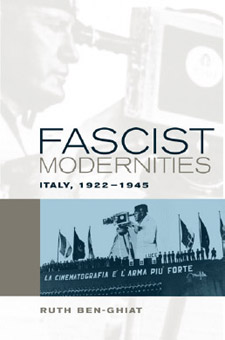 | Title: Fascist modernities: Italy, 1922-1945 Author: Ben-Ghiat, Ruth Published: University of California Press, 2001 Subjects: European Studies | History | Intellectual History | European History Publisher's Description: Ruth Ben-Ghiat's innovative cultural history of Mussolini's dictatorship is a provocative discussion of the meanings of modernity in interwar Italy. Eloquent, pathbreaking, and deft in its use of a broad range of materials, this work argues that fascism appealed to many Italian intellectuals as a new model of modernity that would resolve the contemporary European crisis as well as long-standing problems of the national past. Ben-Ghiat shows that - at a time of fears over the erosion of national and social identities - Mussolini presented fascism as a movement that would allow economic development without harm to social boundaries and national traditions. She demonstrates that although the regime largely failed in its attempts to remake Italians as paragons of a distinctly fascist model of mass society, twenty years of fascism did alter the landscape of Italian cultural life. Among younger intellectuals in particular, the dictatorship left a legacy of practices and attitudes that often continued under different political rubrics after 1945. [brief] Similar Items |
| 11. | 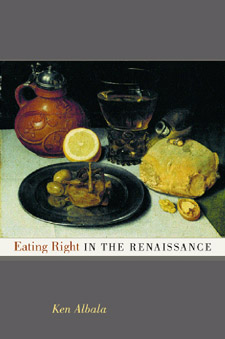 | Title: Eating right in the Renaissance Author: Albala, Ken 1964- Published: University of California Press, 2002 Subjects: Food and Cooking | Renaissance History | History of Science | History of Food Publisher's Description: Eating right has been an obsession for longer than we think. Renaissance Europe had its own flourishing tradition of dietary advice. Then, as now, an industry of experts churned out diet books for an eager and concerned public. Providing a cornucopia of information on food and an intriguing account of the differences between the nutritional logic of the past and our own time, this inviting book examines the wide-ranging dietary literature of the Renaissance. Ken Albala ultimately reveals the working of the Renaissance mind from a unique perspective: we come to understand a people through their ideas on food. Eating Right in the Renaissance takes us through an array of historical sources in a narrative that is witty and spiced with fascinating details. Why did early Renaissance writers recommend the herbs parsley, arugula, anise, and mint to fortify sexual prowess? Why was there such a strong outcry against melons and cucumbers, even though people continued to eat them in large quantities? Why was wine considered a necessary nutrient? As he explores these and other questions, Albala explains the history behind Renaissance dietary theories; the connections among food, exercise, and sex; the changing relationship between medicine and cuisine; and much more. Whereas modern nutritionists may promise a slimmer waistline, more stamina, or freedom from disease, Renaissance food writers had entirely different ideas about the value of eating right. As he uncovers these ideas from the past, Ken Albala puts our own dietary obsessions in an entirely new light in this elegantly written and often surprising new chapter on the history of food. [brief] Similar Items |
| 12. | 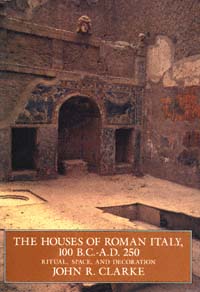 | Title: The houses of Roman Italy, 100 B.C.-A.D. 250: ritual, space, and decoration Author: Clarke, John R 1945- Published: University of California Press, 1992 Subjects: Classics | Art and Architecture | Architectural History | Art History Publisher's Description: In this richly illustrated book, art historian John R. Clarke helps us see the ancient Roman house "with Roman eyes." Clarke presents a range of houses, from tenements to villas, and shows us how enduring patterns of Roman wall decoration tellingly bear the cultural, religious, and social imprints of the people who lived with them.In case studies of seventeen excavated houses, Clarke guides us through four centuries of Roman wall painting, mosaic, and stucco decoration, from the period of the "Four Styles" (100 B.C. to A.D. 79) to the mid- third century. The First Style Samnite House shows its debt to public architecture in its clear integration of public and private spaces. The Villa of Oplontis asserts the extravagant social and cultural climate of the Second Style. Gemlike Third-Style rooms from the House of Lucretius Fronto reflect the refinement and elegance of Augustan tastes. The Vettii brothers' social climbing helps explain the overburdened Fourth-Style decoration of their famous house. And evidence of remodelling leads Clarke to conclude that the House of Jupiter and Ganymede became a gay hotel in the second century.In his emphasis on social and spiritual dimensions, Clarke offers a contribution to Roman art and architectural history that is both original and accessible to the general reader. The book's superb photographs not only support the author's findings but help to preserve an ancient legacy that is fast succumbing to modern deterioration resulting from pollution and vandalism. [brief] Similar Items |
| 13. | 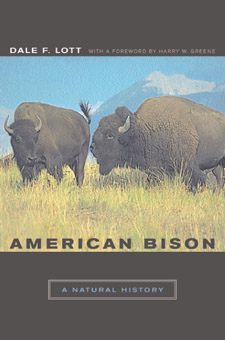 | Title: American bison: a natural history Author: Lott, Dale F Published: University of California Press, 2002 Subjects: Organismal Biology | Mammalogy | Animals | Animal Behavior | Science | Natural History Publisher's Description: American Bison combines the latest scientific information and one man's personal experience in an homage to one of the most magnificent animals to have roamed America's vast, vanished grasslands. Dale F. Lott, a distinguished behavioral ecologist who was born on the National Bison Range and has studied the buffalo for many years, relates what is known about this iconic animal's life in the wild and its troubled history with humans. Written with unusual grace and verve, American Bison takes us on a journey into the bison's past and shares a compelling vision for its future, offering along the way a valuable introduction to North American prairie ecology. We become Lott's companions in the field as he acquaints us with the social life and physiology of the bison, sharing stories about its impressive physical prowess and fascinating relationships. Describing the entire grassland community in which the bison live, he writes about the wolves, pronghorn, prairie dogs, grizzly bears, and other animals and plants, detailing the interdependent relationships among these inhabitants of a lost landscape. Lott also traces the long and dramatic relationship between the bison and Native Americans, and gives a surprising look at the history of the hide hunts that delivered the coup de grâce to the already dwindling bison population in a few short years. This book gives us a peek at the rich and unique ways of life that evolved in the heart of America. Lott also dismantles many of the myths we have created about these ways of life, and about the bison in particular, to reveal the animal itself: ruminating, reproducing, and rutting in its full glory. His portrait of the bison ultimately becomes a plea to conserve its wildness and an eloquent meditation on the importance of the wild in our lives. [brief] Similar Items |
| 14. | 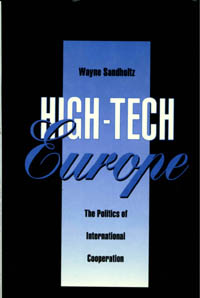 | Title: High-Tech Europe: the politics of international cooperation Author: Sandholtz, Wayne Published: University of California Press, 1992 Subjects: Politics | Public Policy | Economics and Business | Technology and Society Publisher's Description: A study of cooperative efforts in the high-tech industries of Europe. Sandholtz examines why collaboration came late to these countries, how protective walls came down, how countries work together in economically sensitive areas.Governments have recognized for decades the dynamic role played by microelectronics, computers, and telecommunications in the modern economy. Although Europe's deficiencies in these crucial sectors had long been acknowledged, it was not until the 1980s that European nations began collaborating to develop and promote high-tech industries. Their collaboration gives rise to many questions. Why, for example, did the joint efforts come at such a late date rather than in the 1960s or 70s? And how is it possible that they work together in economically sensitive areas? These questions point to fundamental issues in the areas of international cooperation, international institutions, and technology policy.Before the institution of the collaborative programs ESPRIT (European Strategic Programme for Research and Development in Information Technology), RACE (R & D in Advanced Communications-technologies in Europe), and EUREKA (European Research Coordination Agency) in the 1980s, each European country sought its own technological renaissance through protection of national firms behind walls of technical standards, procurement preferences, and research subsidies. Here is a thorough, carefully researched work that examines the breakdown of these walls. It will appeal to political scientists, economists, and scholars of technology and Western Europe interested in the political contours of the high-tech landscape. [brief] Similar Items |
| 15. | 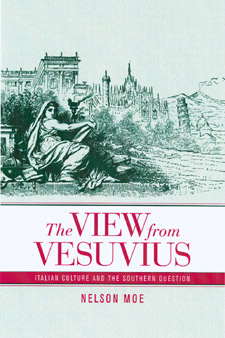 | Title: The view from Vesuvius: Italian culture and the southern question Author: Moe, Nelson 1961- Published: University of California Press, 2002 Subjects: European Studies | European History | Intellectual History | Politics | European Literature Publisher's Description: The vexed relationship between the two parts of Italy, often referred to as the Southern Question, has shaped that nation's political, social, and cultural life throughout the twentieth century. But how did southern Italy become "the south," a place and people seen as different from and inferior to the rest of the nation? Writing at the rich juncture of literature, history, and cultural theory, Nelson Moe explores how Italy's Mezzogiorno became both backward and picturesque, an alternately troubling and fascinating borderland between Europe and its others. This finely crafted book shows that the Southern Question is far from just an Italian issue, for its origins are deeply connected to the formation of European cultural identity between the mid-eighteenth and late nineteenth centuries. Moe examines an exciting range of unfamiliar texts and visual representations including travel writing, political discourse, literary texts, and etchings to illuminate the imaginative geography that shaped the divide between north and south. His narrative moves from a broad examination of the representation of the south in European culture to close readings of the literary works of Leopardi and Giovanni Verga. This groundbreaking investigation into the origins of the modern vision of the Mezzogiorno is made all the more urgent by the emergence of separatism in Italy in the 1990s. [brief] Similar Items |
| 16. |  | Title: Natural history of the White-Inyo Range, eastern California Author: Hall, Clarence A Published: University of California Press, 1991 Subjects: Environmental Studies | Ecology | Earth Sciences | California and the West | Natural History Publisher's Description: The White-Inyo Range - rising sharply from the eastern edge of Owens Valley - is one of the most extraordinary landscapes in the world. High, dry, and amazingly diverse, it boasts an expansive alpine tundra and features the oldest living species on earth - the 4,000-year-old Bristlecone Pines. This colorful and authoritative volume assembles a wealth of information of deep interest to the hikers and scientists attracted to White-Inyo's altitude and isolation.The nearly two dozen contributors to the volume are leading experts on the flora and fauna, the geology, geomorphology, meteorology, anthropology, and archaeology of the area. The book offers descriptions of more than 650 kinds of living organisms, from the handful of fish to the abundance of reptile, amphibian, bird and plant species. (It provides descriptions of hundreds of flowering plants.) It contains an 8-color geologic map and a roadside guide that enables the visitor to make sense of the area's complex geological history. Readers will also learn about air currents that make the range a delight for sailplane pilots and create strange cloud formations. And a special chapter tells what is known of the Native Americans who moved up and down the mountain slopes in response to seasonal changes.For anyone who wishes to visit this astonishing area or to do research there, this volume will be a unique, comprehensive resource. [brief] Similar Items |
| 17. | 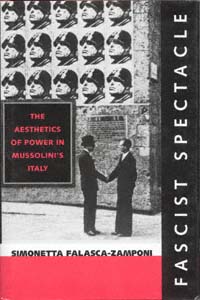 | Title: Fascist spectacle: the aesthetics of power in Mussolini's Italy Author: Falasca-Zamponi, Simonetta 1957- Published: University of California Press, 1997 Subjects: History | European History | Popular Culture | European Studies | Politics Publisher's Description: This richly textured cultural history of Italian fascism traces the narrative path that accompanied the making of the regime and the construction of Mussolini's power. Simonetta Falasca-Zamponi reads fascist myths, rituals, images, and speeches as texts that tell the story of fascism. Linking Mussolini's elaboration of a new ruling style to the shaping of the regime's identity, she finds that in searching for symbolic means and forms that would represent its political novelty, fascism in fact brought itself into being, creating its own power and history.Falasca-Zamponi argues that an aesthetically founded notion of politics guided fascist power's historical unfolding and determined the fascist regime's violent understanding of social relations, its desensitized and dehumanized claims to creation, its privileging of form over ethical norms, and ultimately its truly totalitarian nature. [brief] Similar Items |
| 18. | 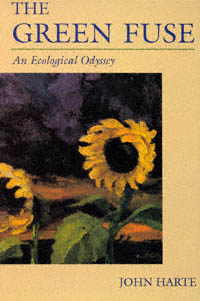 | Title: The green fuse: an ecological odyssey Author: Harte, John 1939- Published: University of California Press, 1993 Subjects: Environmental Studies | Natural History | Ecology Publisher's Description: A widely respected ecological scientist and activist draws on the poet's image and his own environmental research to demonstrate the many interconnections among the world's ecosystems. John Harte takes us from Alaskan salmon runs and the Florida everglades to South Pacific coral reefs and the bleak Tibetan plateau. The result is that rare book that bridges the cultures of science and art. Lyrical, vivid portraits of natural wonders and the threats to them are combined with precise scientific accounts of natural processes and their disturbances. The Green Fuse will show nonscientists the fascination of ecological detective work and renew scientists' love for the beauty of the world under their microscopes.Harte's stories illuminate, without sermonizing, the damage to natural systems brought about by technological hubris and calculated political ruthlessness. "The green fuse" symbolizes the basic unity behind natural diversity. But a fuse may also be the weak link in an overloaded system or the slow burning wick on an ecological bomb. As The Green Fuse reminds us, the energies that created human liberation from nature can also be those that lead to the human destruction of nature. [brief] Similar Items |
| 19. | 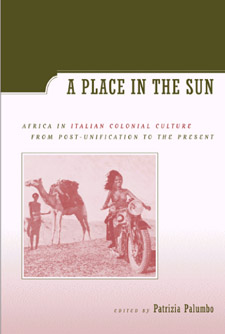 | Title: A place in the sun: Africa in Italian colonial culture from post-unification to the present Author: Palumbo, Patrizia Published: University of California Press, 2003 Subjects: History | Postcolonial Studies | European History | African History | Immigration Publisher's Description: Given the centrality of Africa to Italy's national identity, a thorough study of Italian colonial history and culture has been long overdue. Two important developments, the growth of postcolonial studies and the controversy surrounding immigration from Africa to the Italian peninsula, have made it clear that the discussion of Italy's colonial past is essential to any understanding of the history and construction of the nation. This collection, the first to gather articles by the most-respected scholars in Italian colonial studies, highlights the ways in which colonial discourse has pervaded Italian culture from the post-unification period to the present. During the Risorgimento, Africa was invoked as a limb of a proudly resuscitated Imperial Rome. During the Fascist era, imperialistic politics were crucial in shaping both domestic and international perceptions of the Italian nation. These contributors offer compelling essays on decolonization, exoticism, fascist and liberal politics, anthropology, and historiography, not to mention popular literature, feminist studies, cinema, and children's literature. Because the Italian colonial past has had huge repercussions, not only in Italy and in the former colonies but also in other countries not directly involved, scholars in many areas will welcome this broad and insightful panorama of Italian colonial culture. [brief] Similar Items |
| 20. |  | Title: Italo Balbo: a Fascist life Author: Segrè, Claudio G Published: University of California Press, 1990 Subjects: History | European History | Autobiographies and Biographies | Politics Publisher's Description: Pioneering aviator, blackshirt leader, colonial governor, confidante and heir-apparent to Benito Mussolini, the dashing and charismatic Italo Balbo exemplified the ideals of Fascist Italy during the 1920s and 30s. He earned national notoriety after World War I as a ruthless squadrista whose blackshirt forces crushed socialist and trade union organizations. As Minister of Aviation from 1926 to 1933, he led two internationally heralded mass trans-Atlantic flights. When his aerial armada reached the U. S., Chicago honored him with a Balbo Avenue, New York staged a ticker-tape parade, and President Roosevelt invited him to lunch. As colonial governor from 1933 to 1940, Balbo transformed Libya from backward colony to model Italian province. To many, Italo Balbo seemed to embody a noble vision of Fascism and the New Italy. [brief] Similar Items |